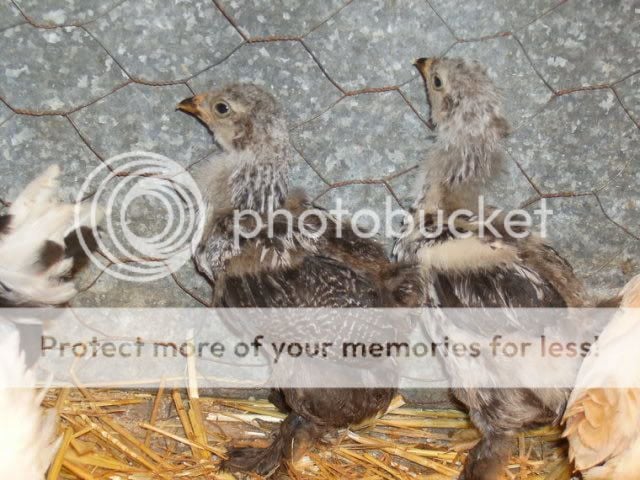does anyone know how to sex Dark Brahms?
Navigation
Install the app
How to install the app on iOS
Follow along with the video below to see how to install our site as a web app on your home screen.
Note: This feature may not be available in some browsers.
More options
You are using an out of date browser. It may not display this or other websites correctly.
You should upgrade or use an alternative browser.
You should upgrade or use an alternative browser.
Dark Brahma
- Thread starter AtRendeAcres
- Start date
Quote:
What he said.

Once we know the age we can probably help more.
What he said.

Once we know the age we can probably help more.
Once the chicks start to feather you'll see the boys have black bodies for the most part and the girls have brown penciled looking feathers instead of black.
 The Dark Brahmas are one of those that the adult boys and girls look very different in color even though they are called "dark"
The Dark Brahmas are one of those that the adult boys and girls look very different in color even though they are called "dark"



Is it similarly possible to sex buff brahmas by color early on?
No it is not La~Poulet,
In Dark Brahmas, the females have pencilling whereas the males have none. In Buff Brahmas, neither sex has pencilling. The same goes for Light Brahmas.
In Dark Brahmas, the females have pencilling whereas the males have none. In Buff Brahmas, neither sex has pencilling. The same goes for Light Brahmas.
Dark brahmas are easy to sex early, they're the only brahma breed you can do by feathers fairly early. As they put in juvenille feathering the males start to look very blotchy, with many feathers part or solid black.
The girls stay nice and evenly pre-pencilled looking. As they mature the boys get blotchier and blotchier and darker until they go black bodied entirely.
They're a favorite here. I'm getting more in the fall...
The girls stay nice and evenly pre-pencilled looking. As they mature the boys get blotchier and blotchier and darker until they go black bodied entirely.
They're a favorite here. I'm getting more in the fall...
Here is a picture of a male and a female chick. The front one is the female with the penciling on the wing.


"Bantam Chickens" by Fred P. Jeffery. page 170 states "Somes(1971) points out that the buff brahma is an auto sexing breed--93 percent accuracy in differintiating males from females at hatching time. All chicks are black on back and head. The male is clear cream-yellow on the upper surface of wings, sides of head, and belly. The female is smokey Gray in these areas."
This also works on partridge check out this picture ..(I know that there are buff in the background but joachim does keep partridge as well so I assume this pic to be correctly labeled
you can check out this post
http://www.americanbrahmaclub.com/a...w/378117-is-there-a-way-to-sex-light-brahmas-
What is said in the picture about the partridges seems to hold true as darks are just silver penciled and partridges are gold penciled.
I know that there is more info around. Surprisingly Brahmas are one of the easier breeds to sex as chicks....additionally if you wait a few weeks the females seem to feather out much more quickly IMO
This also works on partridge check out this picture ..(I know that there are buff in the background but joachim does keep partridge as well so I assume this pic to be correctly labeled
you can check out this post
http://www.americanbrahmaclub.com/a...w/378117-is-there-a-way-to-sex-light-brahmas-
What is said in the picture about the partridges seems to hold true as darks are just silver penciled and partridges are gold penciled.
I know that there is more info around. Surprisingly Brahmas are one of the easier breeds to sex as chicks....additionally if you wait a few weeks the females seem to feather out much more quickly IMO
Quote:
Thank you! That is very helpful. My 3 are all almost exactly the same coloration... going by the cloudy gray description, that makes them sound like females. One has a slightly more copper to the gold feathers around the head, I'll be curious to see if I have 3 of one or 1 different as they grow.
Thank you! That is very helpful. My 3 are all almost exactly the same coloration... going by the cloudy gray description, that makes them sound like females. One has a slightly more copper to the gold feathers around the head, I'll be curious to see if I have 3 of one or 1 different as they grow.
New posts New threads Active threads
-
Latest threads
-
-
Chicks wont stay ubder heat pad?????? Help!
- Started by Chickens_4life123
- Replies: 3
-
-
4mo Old Silkie Bantams - Any guess on gender?
- Started by AllyCat16
- Replies: 1
-
-
-
Threads with more replies in the last 15 days
-
-
-
-
Chicken Butt Emergency ‼️ Please Help!
- Started by urlocalcrazychickenlady
- Replies: 71
-
Ended BYC Poultry Caption Contest 11-28-25 Pic by Ponypoor
- Started by TwoCrows
- Replies: 62
-
×

